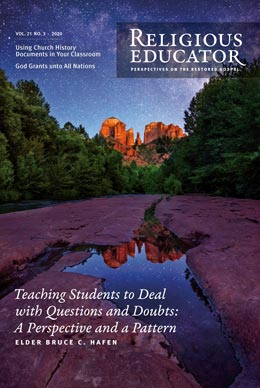Using Church History Documents in Your Classroom
Keith A. Erekson
Keith A. Erekson, "Using Church History Documents in Your Classroom," Religious Educator 21, no. 3 (2020): 45–59.
Keith A. Erekson (keith.erekson@churchofjesuschrist.org) was the director of the Church History Library and a member of the editorial board of the Church Historian’s Press when this was published.
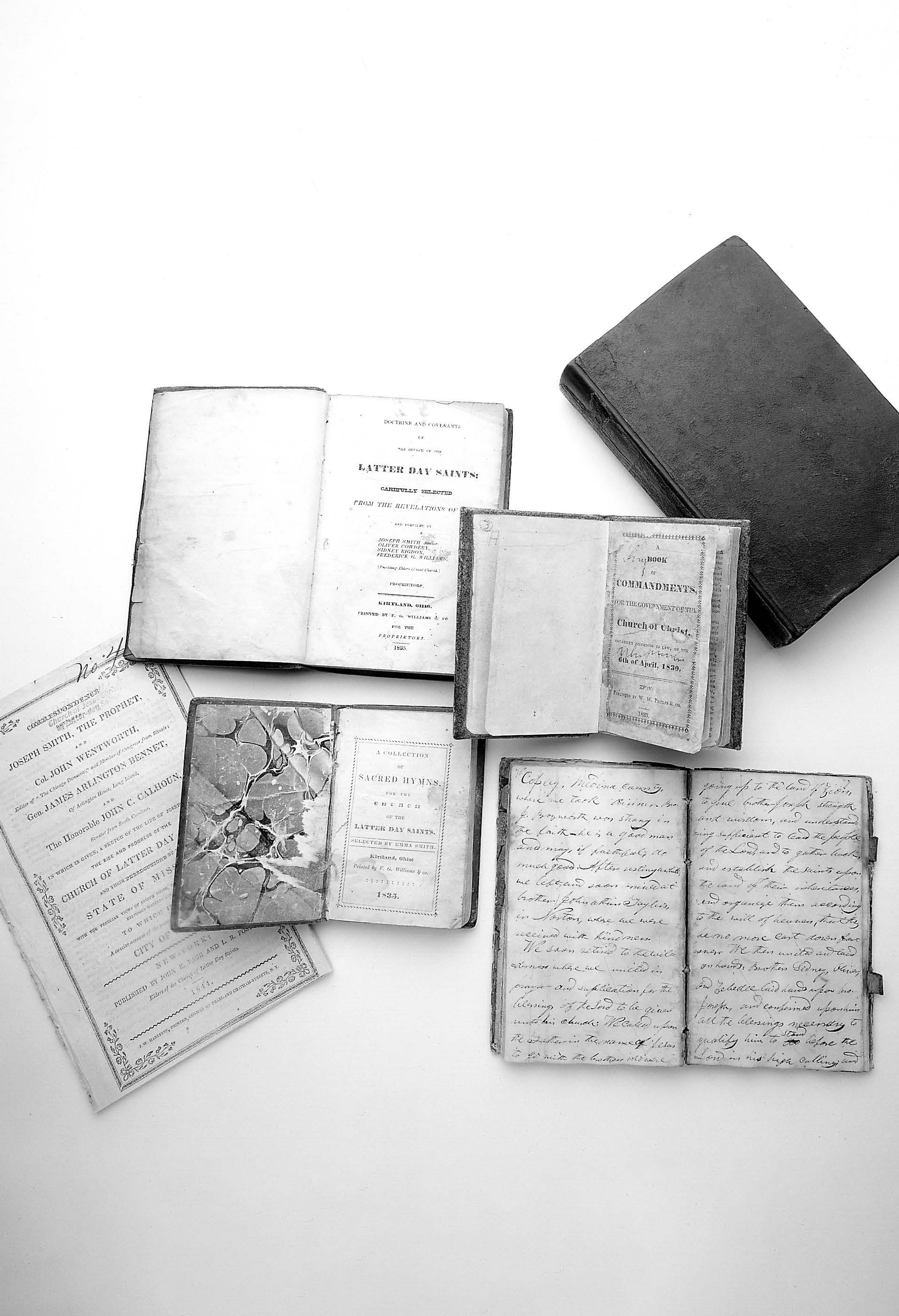 As your students become more familiar with using the documents from Church history, your classroom can become an exciting place for discussion and deeper learning. © IRI
As your students become more familiar with using the documents from Church history, your classroom can become an exciting place for discussion and deeper learning. © IRI
Each of the standard works was compiled from previous historical documents. The Bible emerged from letters and writings selected and evaluated over hundreds of years. Joseph Smith received revelations for more than a decade before some were published in the Doctrine and Covenants. Members of the Quorum of the Twelve Apostles selected some of Joseph Smith’s other writings for inclusion in the Pearl of Great Price. Mormon and Moroni abridged Nephite records to prepare the plates that Joseph Smith translated as the Book of Mormon.
Documents related to the scriptures can strengthen faith and enrich teaching. Long before Mormon abridged the records, Alma passed them to his son Helaman with an endorsement of the unabridged documents’ uses and value. Alma explained that the records had “enlarged the memory of this people” (Alma 37:8), a benefit of remembrance that we commonly attribute to history. He also testified that the records served a purpose in the work of conversion and gathering: the information “convinced” thousands of Lamanites “of the incorrect tradition of their fathers,” and the records “brought them unto repentance” and led them “to rejoice in Jesus Christ their Redeemer” (Alma 37:9).
Documents from the history of The Church of Jesus Christ of Latter-day Saints can likewise strengthen your students. Where does the Church keep its historical documents today? How can your students encounter them? How might the use of Church history documents enrich the learning and teaching in your classroom? How might such documents be used in your own professional development? In answering each of these questions, this article will provide a solid working knowledge of the wealth of resources available to you and your students.
The Church Preserves Historical Documents
On the day of the Church’s organization, Joseph Smith received a revelation instructing that “there shall be a record kept among you” (Doctrine and Covenants 21:1). Elder Quentin L. Cook observed that when the Saints crossed the plains, the Church’s records fit into a single wagon. Elder Cook noted, “Not anymore! The Church opened a new, state-of-the-art Church History Library in 2009,” and it “contains a tremendous variety of materials.” The library’s holdings span the Church’s chronological history from the 1820s to yesterday; its geographical expansion from New York to the world; its ethnic and linguistic variety, including items in more than 150 languages; and its organizational structure from its headquarters in Salt Lake City to the smallest local Church unit.
Elder Cook went on to explain, “The records range in age and type from fragments of papyrus created before the birth of Jesus Christ (which came into the possession of Joseph Smith in Kirtland) to bits of information entered recently into any of the Church’s electronic systems for tracking missionaries or temple ordinances. Records stored in the library are made out of seemingly every kind of material—paper made from linen, cheap wood pulp, and modern commercialized processes; photographs taken on glass plate negatives and with high-speed digital cameras; audio recorded on wax cylinders, metal wires, or MP3 files; video recorded on film strips, VHS tapes, and Blu-Ray discs; electronic files created with word-processing software or archived from websites.” These records can teach us much. He continued, “The breadth of materials testifies to the Church’s ongoing efforts to spread the word of God across the earth in every possible way. The Church carefully preserves all of these records so that we can continue to learn from them. These records also allow us to see the personal sides of Church leaders and members.”[1] Located in downtown Salt Lake City, with satellite storage facilities in more than two dozen locations around the world, the Church History Library holds the world’s largest collection of sacred records about the history of the restored Church.
Your Students Can Encounter Church History Documents
There are many ways your students might benefit from an encounter with the historical documents preserved by the Church. Seeing photographs of the people, places, and events described in each lesson will help them visualize and remember past events. Witnessing Joseph Smith’s handwriting on a document can help him feel more real and personal to them.[2] Seeing the pages of the Book of Commandments that were rescued from mob destruction by young girls can both bring the past into the present and demonstrate the important contributions that youth can make to our current history.[3] Viewing the sources of history can help students better understand how our knowledge of the past develops.
Perhaps the easiest way to find sources of interest and relevance is through citations in materials you are already using. The endnotes in the Church’s new, four-volume narrative history, Saints, cite the original sources used to tell the Saints’ compelling stories.[4] In the electronic version of Saints—in the Gospel Library app or on the Church’s website—the citations are often hyperlinks that point directly to images of the original documents in the Church History Library’s online catalog. During the preparation of Saints for publication, the library’s staff digitized the cited sources for readers to explore.
Other solid resources on Church history also cite original sources in the library’s collection. The endnotes of the Gospel Topics Essays point to sources for understanding some of the tough questions from our past, such as plural marriage, blacks and the priesthood, and the methods of scripture translation.[5] The publication of Saints has been accompanied by the release of nearly two hundred essays on “Church History Topics” that provide additional information on people, places, events, and issues in Church history. Some address additional topics of interest to students, including Masonry and the temple endowment, the Danites, the Kinderhook Plates, and Joseph Smith’s 1844 campaign for the U.S. presidency.[6] The information in some of these essays is being brought to life in an engaging video format in the Church’s Now You Know series.[7]
Your students can also encounter historical documents in several curated collections. Scholars and experts in the Church History Library have selected significant records and presented them with commentary and analysis. The library’s Foundations of Faith exhibit presents accounts of the First Vision, early editions of modern scripture, the papers of modern prophets, and documents related to living the gospel, gathering Israel, and building temples.[8] Significant documents from black Latter-day Saint history have been identified and digitized, including certification of Elijah Able’s priesthood ordination, Jane Manning James’s autobiography, and testimonies of twentieth-century converts.[9] Art curators have selected artwork from around the world that depict the First Vision and the pioneer experience.[10]
The Joseph Smith Papers website organizes Joseph’s materials into multiple series: Documents, Journals, Administrative Records, Revelations and Translations, Histories, and Legal and Financial Records. The site features significant reference materials, including a glossary of historical terms, lesson plans, and descriptions of people, events, and places named in the papers. The Featured Topics section of the site (under Reference in the top navigation menu) identifies documents related to important topics, including accounts of the King Follett Sermon, the Council of Fifty, the First Vision, and Religious Freedom. And, don’t miss the index to the original sources from which Joseph Fielding Smith drew his popular Teachings of the Prophet Joseph Smith (1938).[11]
The Church Historian’s Press website offers full-text searchable editions of a growing number of significant records from Church history. There is a collection of documents, The First Fifty Years of the Relief Society, that includes the minute book of the Female Relief Society of Nauvoo. Another collection of sermons by Latter-day Saint women, At the Pulpit, presents powerful examples of women teaching and exhorting. The site also hosts the journals of George Q. Cannon, Franklin D. Richards, and Emmeline B. Wells, with more on the way.[12]
The Church History Library hosts a database of authenticated information about early Church members like pioneers and missionaries. Users may search by name to find information and sources about ancestors or other persons from Church history. The facts in the Pioneer Database search interface provide useful context for experiences with the pioneer trek.[13] The missionary interface leads to information about historical conditions missionaries faced concerning geography, transportation, and demographics.[14] Both databases have been cross-linked with the FamilySearch Family Tree, so users may quickly connect from the database to their ancestors in the tree.[15]
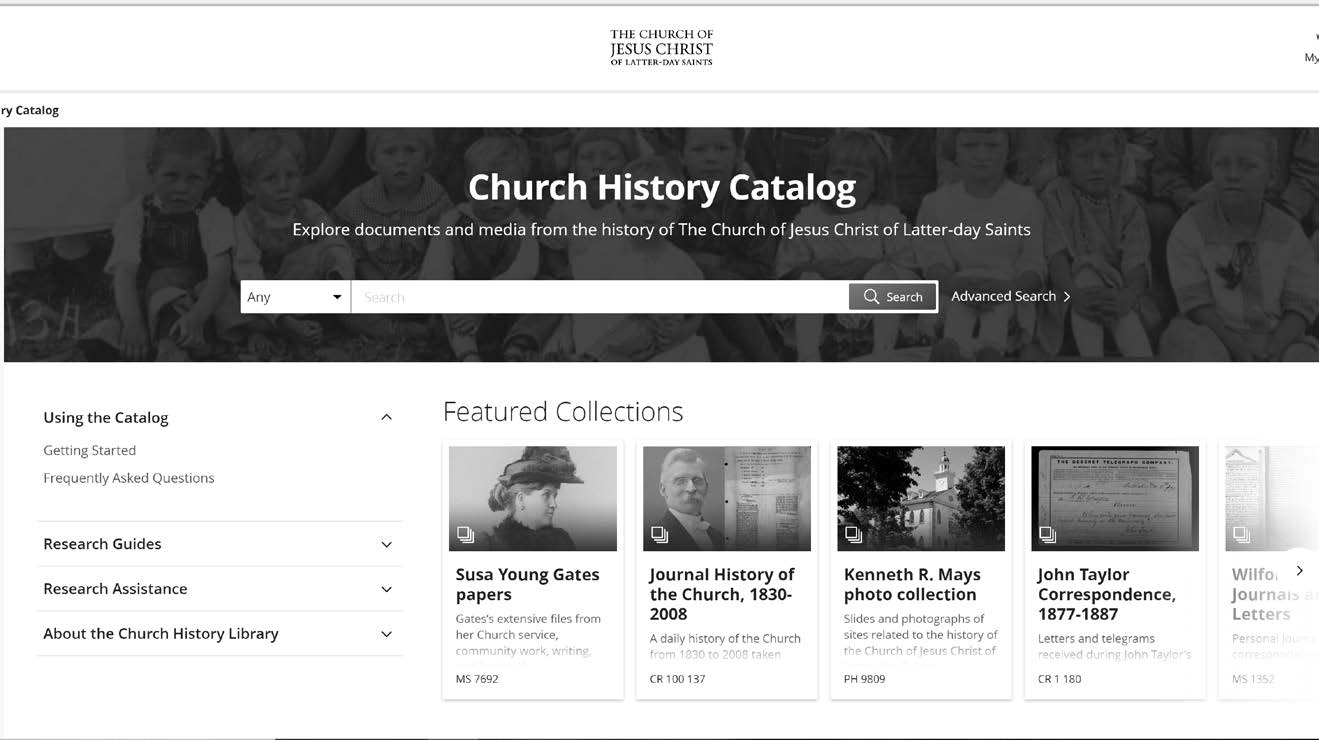 Access the Library’s collections online at catalog.churchofjesuschrist.org.
Access the Library’s collections online at catalog.churchofjesuschrist.org.
Finally, your students may also enjoy the opportunity to search directly in the Church History Library’s online catalog for documents that interest them. The search box leads to documents in the collection, and significant collections are featured on the page, including photos, letters, and architectural plans. Today there are more than 18 million digital assets in the catalog, and the library’s staff continues to scan and post historical documents at a rate of approximately three hundred new images per hour. Some items may have copyright restrictions and require searchers to log in using their Church account. Other items may be restricted if they contain information that is sacred, confidential, or private.[16] The catalog’s landing page also links to research guides containing advice, tips, and collections about general Church history, Church leaders, women in Church history, blacks in Church history, general conference, sources for family and local history, and more.[17]
Church History Documents in Your Classroom
As your students become more familiar with using the documents from Church history, your classroom can become an exciting place for discussion and deeper learning. Their interest and abilities will allow you to prepare differently for your lessons. Plan to engage them in reading, analysis, and discussion.
Teach How to Analyze
One way to develop your lessons might involve teaching and reinforcing the skills for analyzing documents and sources. You might begin by helping your students understand that the past is gone and only pieces of the past—like these documents—remain in the present. Further, these documents and facts about the past don’t “speak for themselves”; instead, they need to be interpreted and placed in their proper contexts. The past was different (and that’s all right), so we need to try to understand it on its own terms, not with our own assumptions from the present. Learning history this way requires humility because we don’t find all of the answers, but our understanding can grow over time.[18]
Create Learning Routines
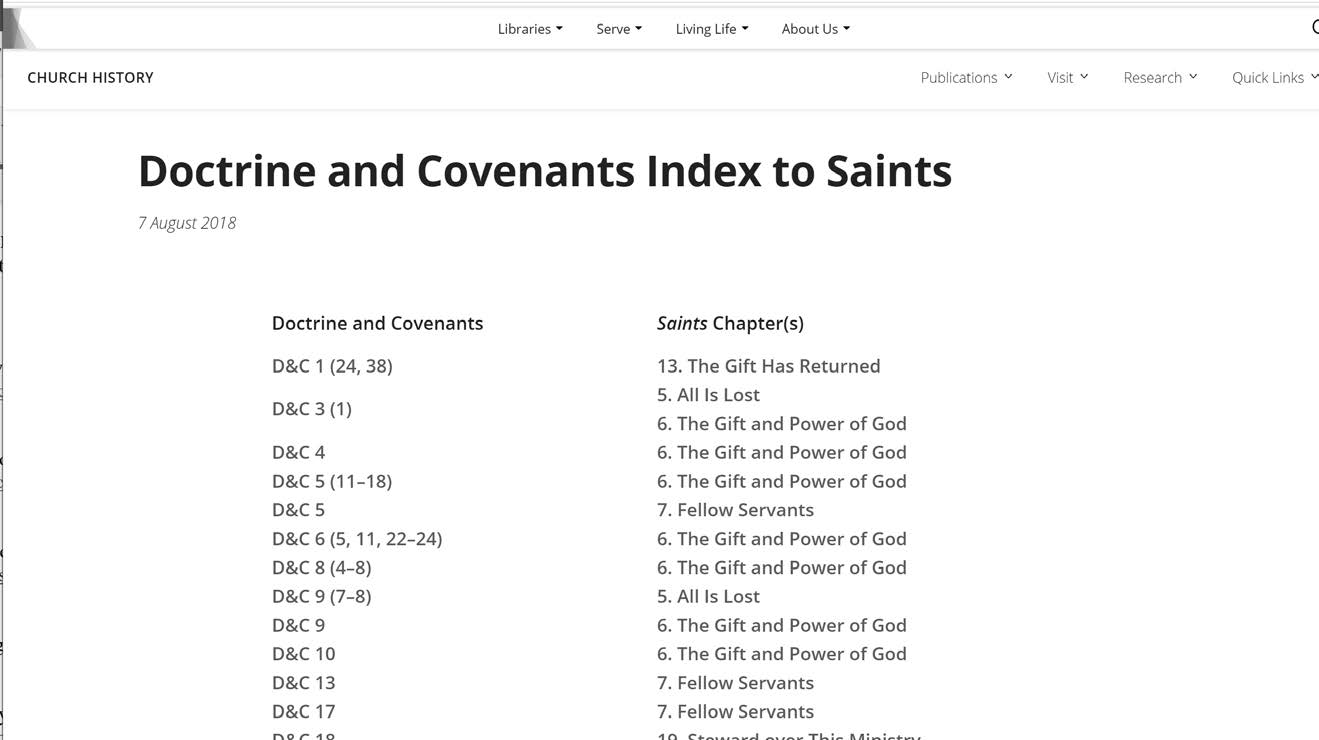 One click takes you to the passage in Saints that discusses each section.
One click takes you to the passage in Saints that discusses each section.
You can translate these general concepts about analysis into specific skills for reading and analyzing documents. You might create learning routines that encourage your students to begin asking questions before they read a document, examine documents closely to understand their meaning, place ideas into context, and understand different types of significance.[19] To help you find information about the origins of each revelation, the website for Saints features an index to the Doctrine and Covenants that links directly to the passages in the book that describe each revelation.[20] Steven C. Harper’s Making Sense of the Doctrine and Covenants (2008) describes the origin, content, and outcomes of each revelation.[21]
Explore the Earliest Copy
Each section in the Doctrine and Covenants had a prehistory before being published. For each, a moment in the Church’s history prompted the need to communicate with heaven, and the revelations came both to answer the Saints’ present questions and to guide them into the future. The Joseph Smith Papers website hosts a Featured Topics page that identifies the earliest copy of each revelation, most of which are handwritten. Your students can zoom in on the old handwriting, read a typed version of the text, and click on links that provide information about general historical background and specific words and concepts within the revelation.[22]
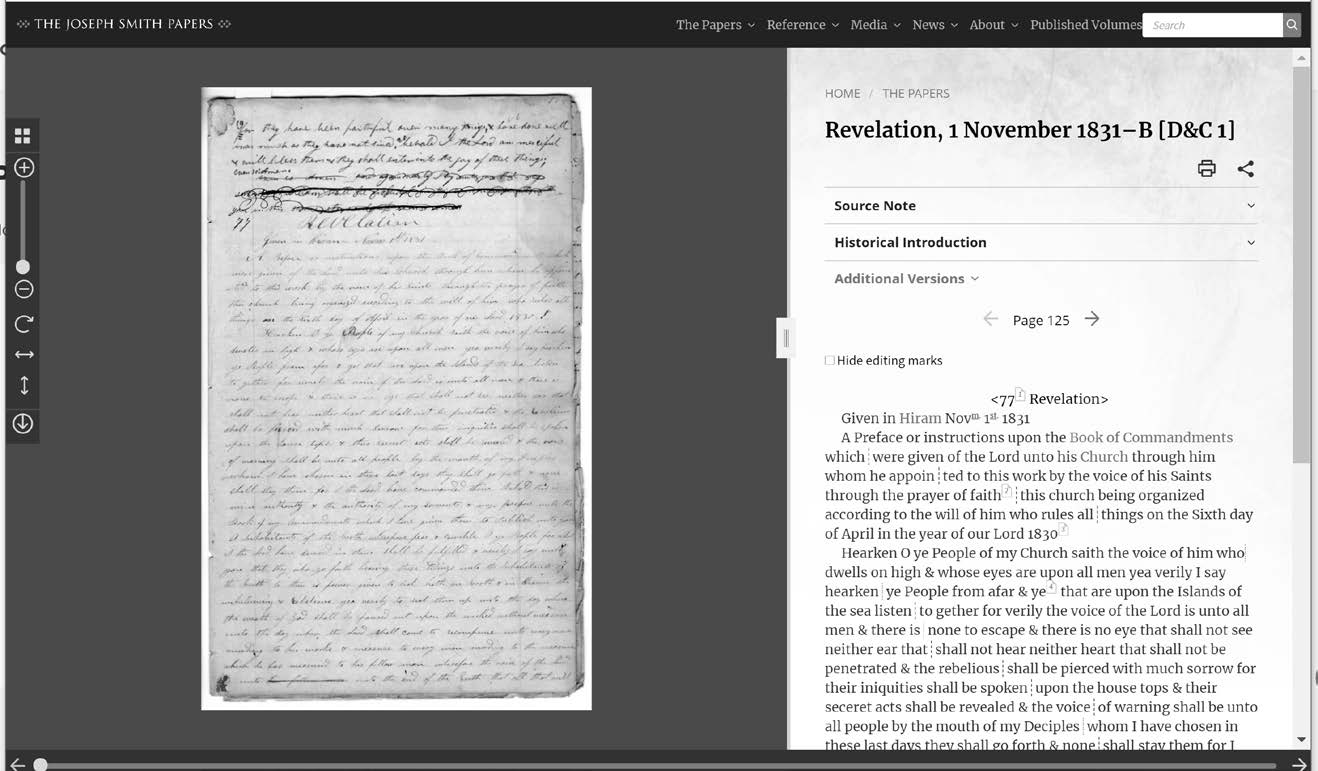 The earliest manuscript of Doctrine and Covenants section 1 on the Joseph Smith Papers website. [23]
The earliest manuscript of Doctrine and Covenants section 1 on the Joseph Smith Papers website. [23]
Connect the Revelations
Many of the revelations in the Doctrine and Covenants relate to other revelations. For example, sections 3 and 10 instruct Joseph about how to respond to the loss of the 116 manuscript pages of the Book of Mormon translation. Sections 6 through 9 contain guidance for Oliver Cowdery as he worked as Joseph’s scribe in the Book of Mormon translation process. The book Revelations in Context: The Stories behind the Sections of the Doctrine and Covenants (2016) is available on the Church’s website and in the Gospel Library app. The essays in this book identify related revelations and describe the backstories and connections behind them.[24]
Seek Insight from Additional Documents
Because the past is gone, historians use multiple documents to reconstruct what happened and enrich our understanding. Saints can help with this process. For example, to enable your students to understand the dedicatory prayer of the Kirtland Temple (Doctrine and Covenants 109), you might look to chapter 21 of the first volume of Saints, “The Spirit of God.” About midway through the chapter you’ll find Joseph Smith reading the prayer to the congregation. Endnote 11 reveals that the information in this part of the story comes from the minutes of the dedication, Joseph Smith’s journal, and the journal of Oliver Cowdery. If you are reading an electronic edition of Saints, you may click on the links in the endnotes to go directly to the original sources in the Church History Library catalog or the Joseph Smith Papers website.
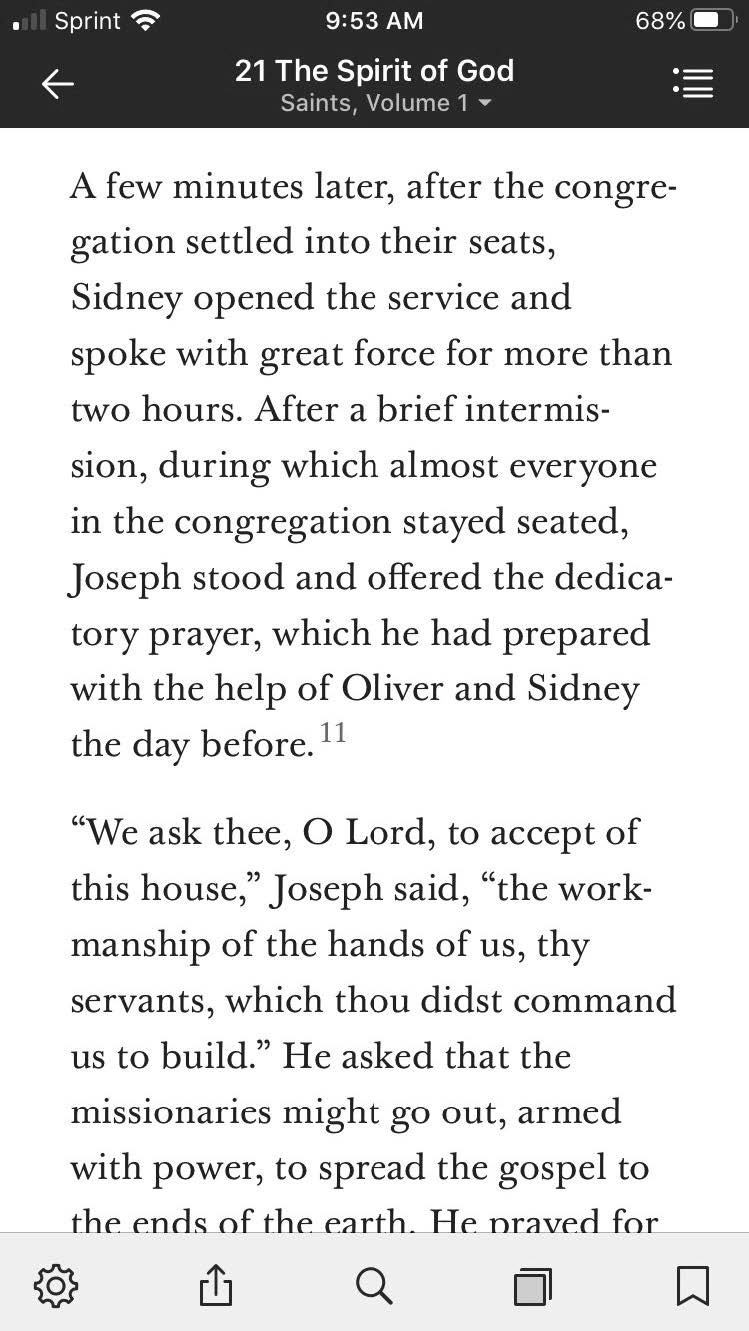
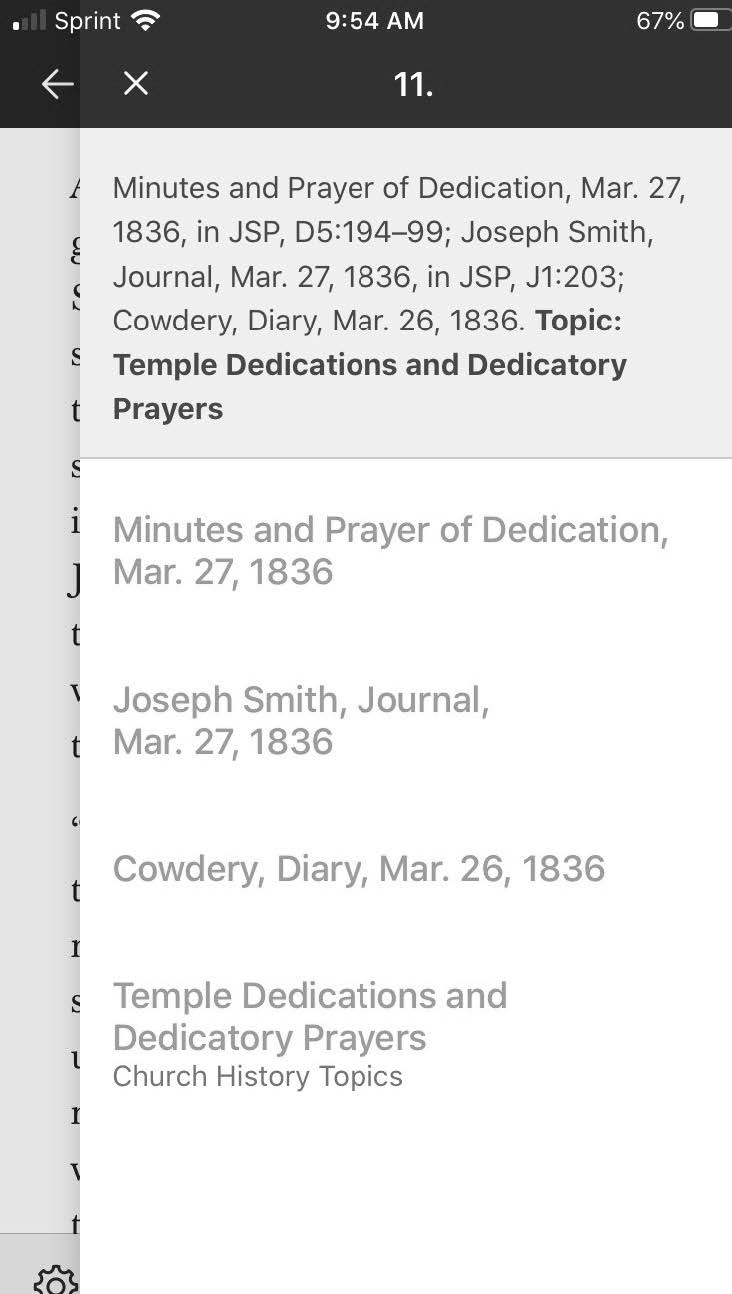 Click on links in an electronic edition of Saints to view original sources
Click on links in an electronic edition of Saints to view original sources
Church History Documents and Your Professional Development
The Church’s historical documents, together with the services of the Church History Library, can also assist you in your own professional development as a gospel teacher.
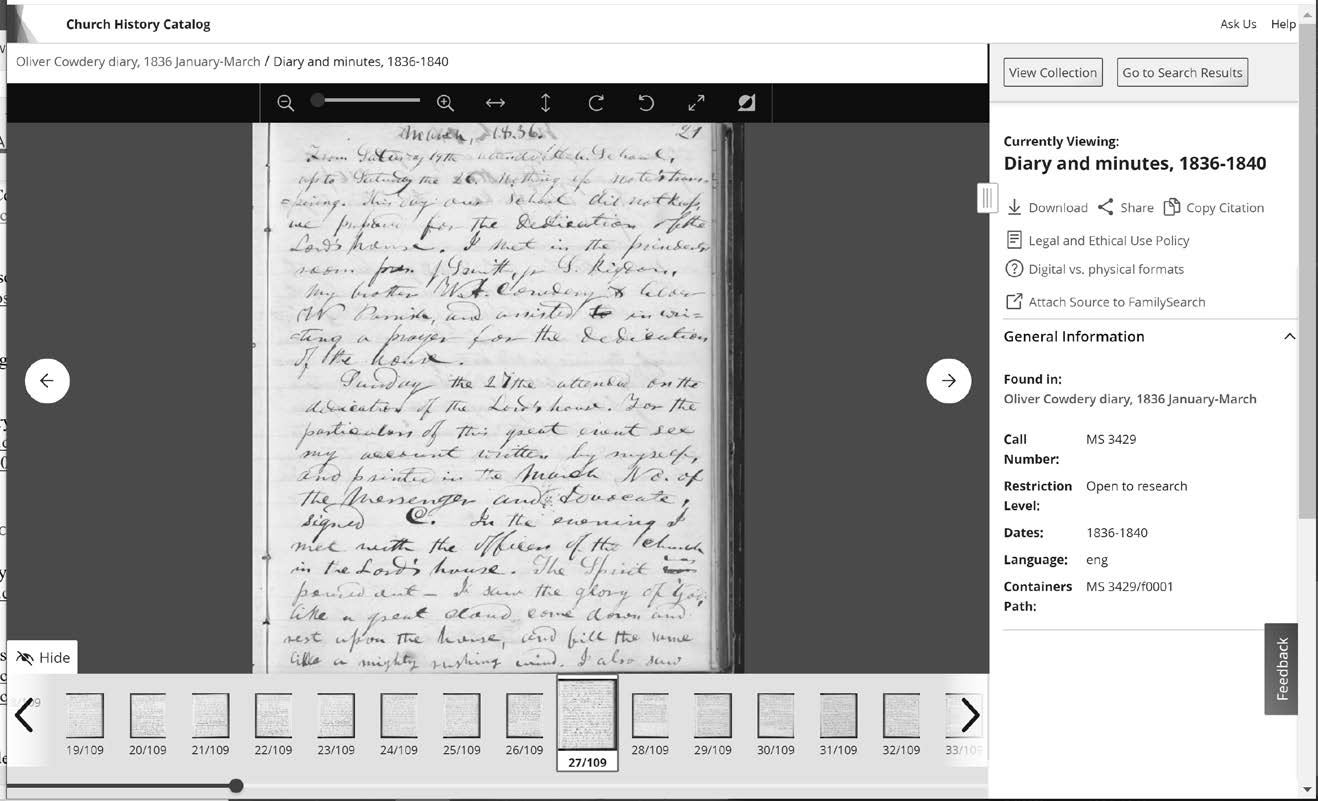 Use Saints to find additional sources about the revelations you are studying. Click on the endnote number to be taken to the notes; click on a source in the note to see the original.
Use Saints to find additional sources about the revelations you are studying. Click on the endnote number to be taken to the notes; click on a source in the note to see the original.
Ask Us
The Library’s website and catalog feature links to the Ask Us section, through which you may submit individual questions. The links open an online form where you may ask questions and share information. Common questions involve finding sources for oft-circulated quotes and verifying the accuracy of rumors. You might ask also about the history of the Church in your community or for help finding something of interest in our catalog. Questions are answered by a team of archivists, librarians, and historians who are standing by to consult with you.
Visit the Library
You might schedule a visit in person or virtually to see documents, ask questions, or talk about teaching. Visitors to the library may view original documents on public display or see original records in the reading room. Our Foundations of Faith exhibit displays some of our most priceless treasures, including a page from the original manuscript of the Book of Mormon, a copy of the extremely rare Book of Commandments, personal journals of early Church leaders, and founding records of Church organizations and activities. Temporary exhibits showcase records related to anniversaries and milestones. The Church History Library has hosted groups of seminary and institute teachers for training events. Additionally, specific presentations—such as learning how to use original records and documents to teach about the First Vision, the Book of Mormon translation, the restoration of the priesthood, or plural marriage—can be prepared to meet your needs.
Research in the Library
As your career develops, you may seek the opportunity to conduct original historical research as part of a course or an advanced degree program. You may access our online catalog from anywhere in the world, and our consultation team can help you design a research strategy to find what you seek. Researchers who visit the library building in person may browse reference materials in the open stacks, but most of the library’s materials are stored in secure stacks and require being called to a reading room for viewing. In preparation, patrons watch a brief orientation video and register using a Church account. The orientation reviews standards of appropriate conduct and explains policies related to access and use. Upon registration, patrons may request items from the secure stacks, save online searches, and access additional digital assets in the online catalog. Registration may be completed online before arriving at the library.
A Small and Simple Thing
The Church preserves historical documents for the benefit of the Church. Bringing these records into your classroom and lesson planning is a “small” thing, but referring to the value of original records, Alma taught “that by small and simple things are great things brought to pass” (Alma 37:6). He testified to Helaman that the original Nephite records had “convinced many of the error of their ways” and “brought them to the knowledge of their God unto the salvation of their souls” (Alma 37:8). He also believed that original records held the potential to do much more. “Who knoweth,” he asked, “but what they will be the means of bringing many thousands” more people “to the knowledge of their Redeemer?” (Alma 37:10). May the original records of the Restoration bless you and your students as you find, analyze, and discuss their contents. May your understanding and memory grow as you see the ways that the Lord has blessed Church leaders and members in the latter days.
Top 5 Resources for Original Church History Records
1. Church History Catalog
The Church History Catalog (catalog.churchofjesuschrist.org) is the principal resource for searching the Library’s collection of archival, manuscript, and print materials. The images of digitized records may be viewed online (some require a log in with a Church account). Simple and advanced searches for names, places, and topics yield results that may be narrowed by material type, date, and language. Wildcard and Boolean searches are also supported. Millions of digitized images are added to the catalog each year and users may recommend sources for future digitization. Materials in the catalog come from a wide spectrum of sources and represent numerous points of view. Users of the catalog should not assume that the Church or the library endorses every item in the collection.
2. Database of People from Church History
Two search interfaces point to original records about individual members of The Church of Jesus Christ of Latter-day Saints. The missionary interface (history.churchofjesuschrist.org/
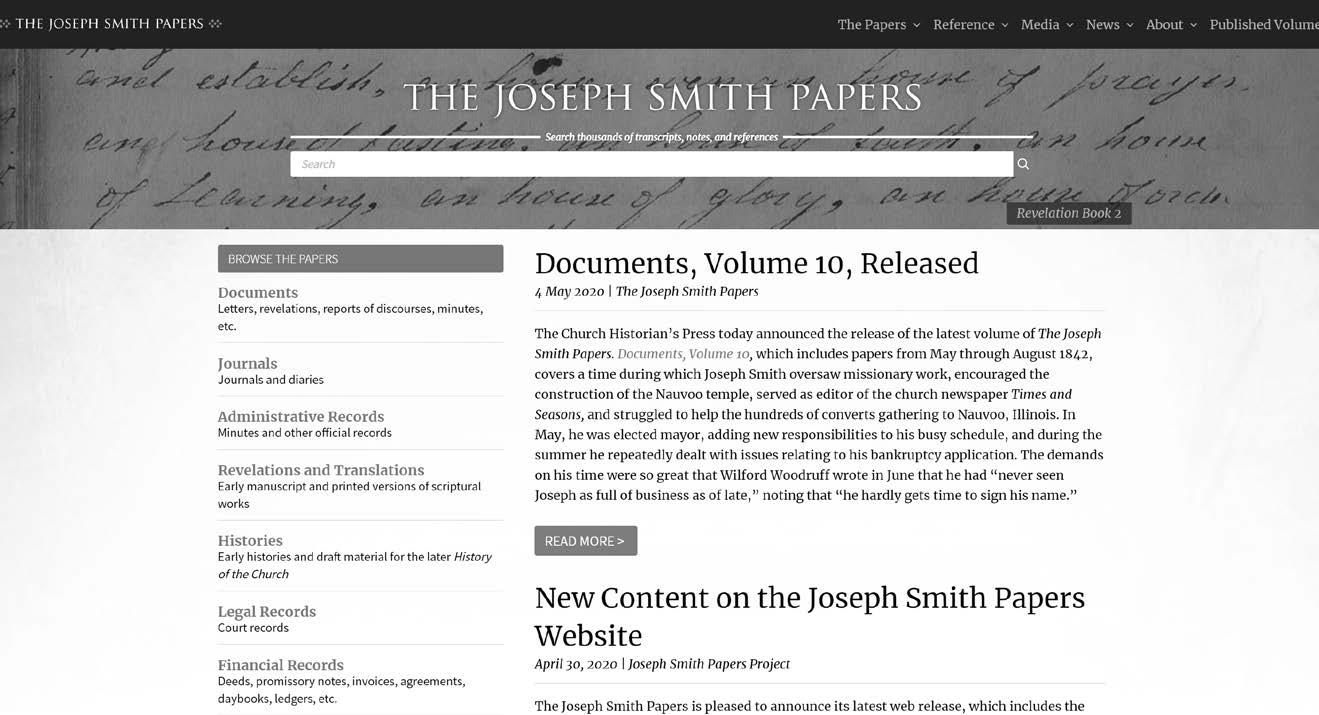 The Joseph Smith Papers website.
The Joseph Smith Papers website.
3. Research Guides
The Library’s growing collection of research guides (history.churchofjesuschrist.org/
4. Joseph Smith Papers website
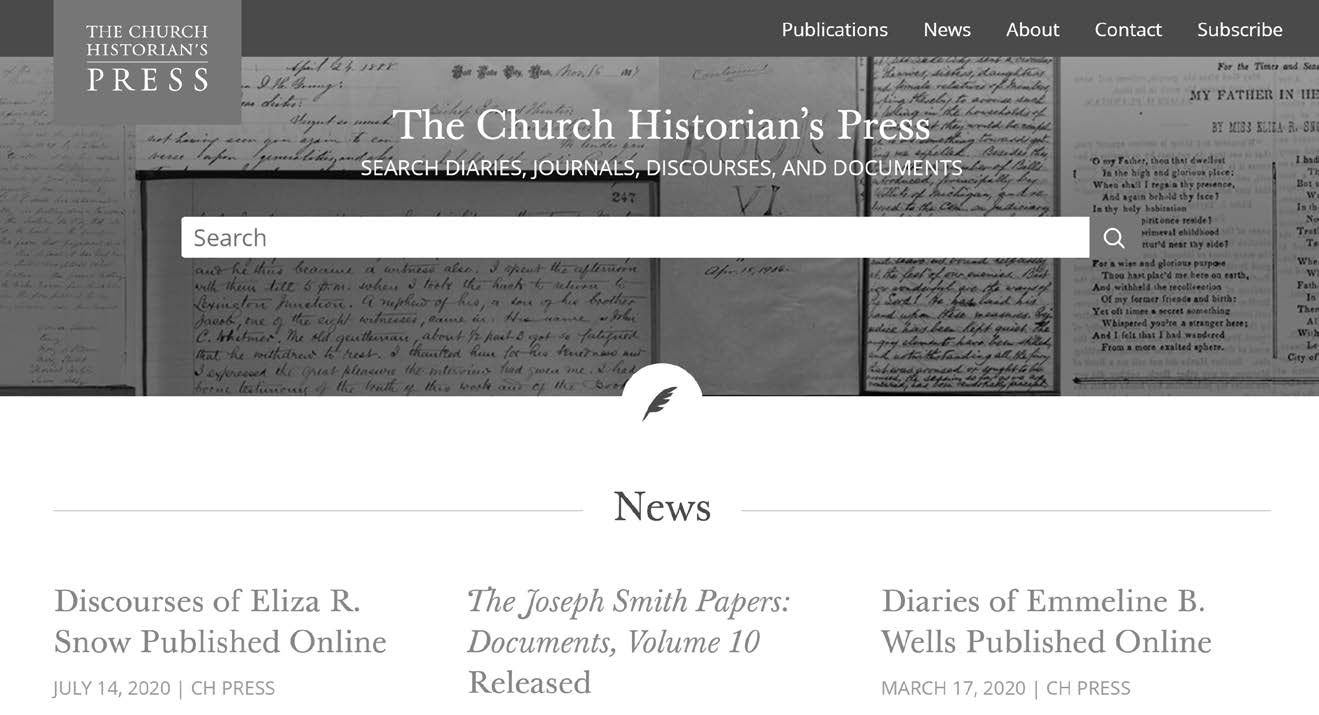 The Church Historian’s Press website.
The Church Historian’s Press website.
The Joseph Smith Papers Project is an effort to gather all existing Joseph Smith documents and publish them with both textual and contextual annotation. The website (josephsmithpapers.org) presents both images and transcriptions of documents from the Church History Library and from other libraries and archives, wherever Joseph Smith documents may be found. The records are presented in series groupings of documents; journals; administrative records; revelations and translations; histories; and legal, business, and financial records.
5. Church Historian’s Press website
Some of the library’s most significant collections are transcribed for full-text searching on the website of the Church Historian’s Press (churchhistorianspress.org). At present, the site hosts selected sermons by Latter-day Saint women (1831–2016), documents from the first fifty years of the Relief Society (1842–1892), the journal of George Q. Cannon (1849–1901), the journal of George F. Richards (1880s–1950), the diaries of Emmeline B. Wells (1844–1920).
Notes
[1] Quentin L. Cook, “Out of Obscurity: How Merciful the Lord Has Been” (BYU–Idaho devotional, Rexburg, ID, 12 June 2018), https://
[2] “Documents in Joseph Smith’s Handwriting,” The Joseph Smith Papers, https://
[3] One of the twenty-eight surviving copies of the Book of Commandments has been digitized and posted in the library’s catalog at https://
[4] Saints: The Story of the Church of Jesus Christ in the Latter Days, 4 vols. (Salt Lake City: The Church of Jesus Christ of Latter-day Saints, 2018–). Two of the volumes have been released: volume 1, The Standard of Truth, 1815–1846 (2018), and volume 2, No Unhallowed Hand, 1846–1893 (2020).
[5] The Gospel Topics Essays are available in the Restoration and Church History section of the Gospel Library app and online at https://
[6] See Church History Topics in the Church History section of the Gospel Library app and online at https://
[7] Now You Know, Inspiration, https://
[8] "Foundations of Faith", Church History, https://
[9] Keith E. Erekson, “Significant Documents from Black Latter-day Saint History,” The Historical Record (blog), 21 May 2018, https://
[10] “Artistic Interpretations of the First Vision,” Church History, https://
[11] See the papers and reference material at josephsmithpapers.org. For tips in navigating the site, see Nathan N. Waite, “Using the Joseph Smith Papers Website: An Introduction,” Religious Educator 20, no. 2 (2019): 105–21.
[12] See the Church Historian’s Press online at https://
[13] See the Pioneer Database, pioneer.churchofjesuschrist.org. See also Keith A. Erekson, “5 Things We Learn from Database of Mormon Pioneers,” Church News, 23 July 2015, https://
[14] See the Missionary Database, history.churchofjesuschrist.org/
[15] To see your ancestors in the pioneer database, visit https://
[16] Visit the Church History Library’s catalog at https://
[17] The research guides may be accessed directly at https://
[18] See Keith A. Erekson, “Understanding Church History by Study and Faith,” Ensign, February 2017, 56–59.
[19] See Keith A. Erekson, “A Pattern for Learning Church History by Study and Faith,” Church History, posted 12 April 2017, https://
[20] “Doctrine and Covenants Index to Saints,” Church History, https://
[21] Steven C. Harper, Making Sense of the Doctrine and Covenants: A Guided Tour through Modern Revelations (Salt Lake City: Deseret Book, 2008).
[22] “Correlation of Current Doctrine and Covenants with Earliest Sources on the Joseph Smith Papers Website,” The Joseph Smith Papers, https://
[23] “Revelation, 1 November 1831–B [D&C 1],” 125, The Joseph Smith Papers, https://
[24] Matthew McBride and James Goldberg, eds., Revelations in Context: The Stories behind the Sections of the Doctrine and Covenants (Salt Lake City: The Church of Jesus Christ of Latter-day Saints, 2016).
